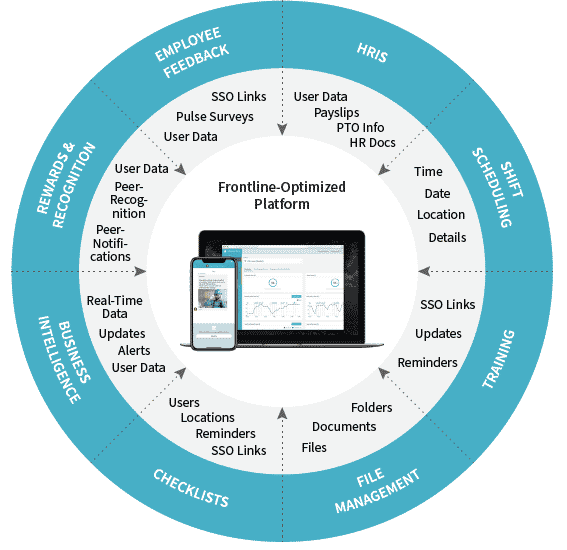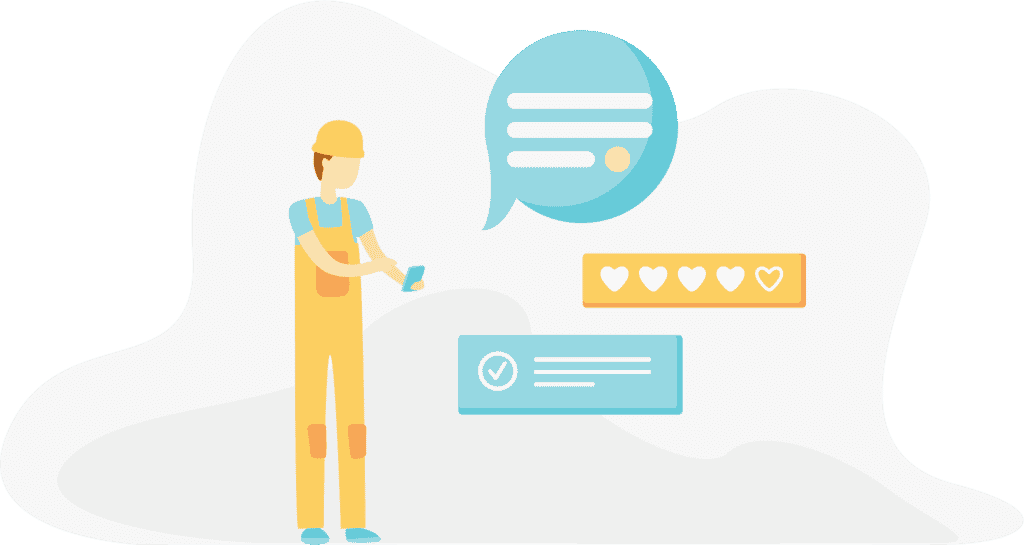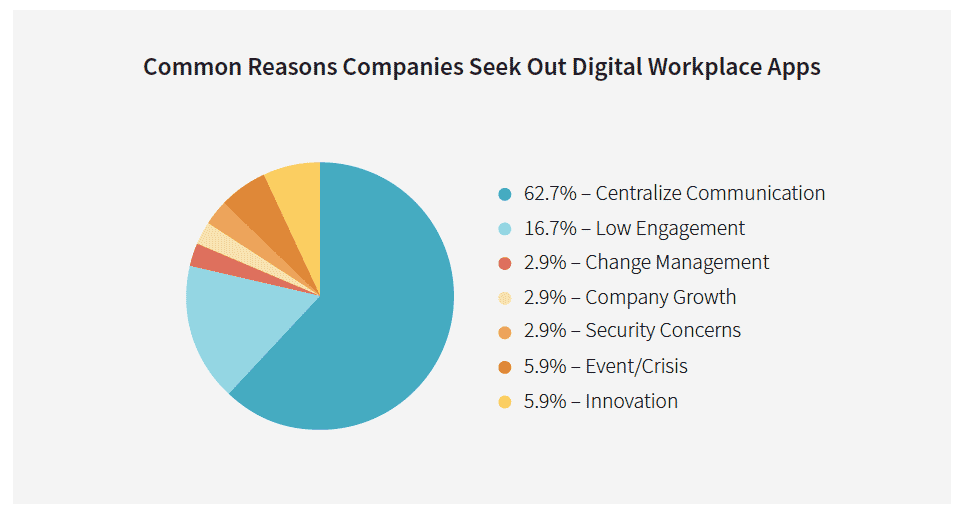FFOW Part 4: Digital Enablement and the Connected Worker

Welcome to Part Four of our Frontline Future of Work blog series! If you haven’t read Part One, Part Two, or Part Three yet, check them out! Part 4 of our series explores why it’s so important to digitally enable frontline workers.
Let’s get started.
The phrase, “these unprecedented times,” has become a bit of a cliche for the moment, but like a lot of other cliches, it sprouted from a kernel of truth. Facing that truth head-on, day to day, are the frontline workers around the world who are being asked to function in a manner that is indeed unprecedented.
Fortunately, the majority of forward-thinking companies have made it possible for frontline workers to operate safely and effectively through implementing a number of digital enablement strategies. To invoke another cliche, this is often a case where “what’s good for the goose is good for the gander.” Digital enablement platforms can help both frontline workers and organizations navigate a host of new and complex issues.
Among these issues are:
- New labor regulations that determine not only how a frontline worker operates, but also when and where.
- Enhancing and fostering interpersonal communication with an increasingly diverse workforce, who often speaks multiple languages.
- Staying compliant with updated public health guidelines and rules.
- Making company knowledge and know-how both readily available and consistent during disruptions in the workforce.
In recent months, it’s been proven time and again how effectively digital tools address the ever-evolving complexities of our current era. Whether it’s facilitating communication throughout an organization or helping uncover new efficiencies on the ground floor, creating a digital workplace is not merely a technological change — it’s a complete cultural change.
Defining Terms: What Is a Digital Workplace?
Given the recent explosion in new digital tools and communications solutions, it stands to reason that companies are searching for a way to bring them together into a single experience. The desire to organize often disparate elements into a cohesive whole is innately human.
Einstein spent the latter half of his career in an ill-fated search for a “unified field theory” to create a single theoretical framework for physics. Fortunately, companies with a large frontline workforce can already access unified frameworks that bring together an array of processes and communications channels.
The digital workplace is already here. So what is it?
Ideally, a digital workplace serves organizations, particularly its frontliners, by supporting a variety of task-specific needs. Chief among them is the need for a unified communication platform that enables frontline workers to connect at any time, anywhere with the information they need — when they need it.

Frontline workers are often in the unique position of having to triage situations in real-time. The lack of adequate access to an organization’s knowledge base can impede this ability and as a result, issues can snowball into outright crises. Similarly, one of the defining characteristics of the present moment is the fact that a lot of frontline work is conducted in distributed or even virtual environments. Once again, access to information and resources outside of the physical workplace is paramount to maintaining operations.
Digital enablement of frontline employees helps the connected worker become both more productive and autonomous, which empowers them to make valuable contributions to organizations. Building a data-driven organization that allows employees to access and use data on-demand adds to a frontliner’s ability to make informed decisions and effectively address issues while enhancing their workflow.

Moreover, high-functioning digital workplaces support many different needs from standard business applications such as email, virtual meetings, and instant messaging to workflow automation and task management. In short, a digital workplace centralizes communication — not just for frontline employees — but for everyone in the organization.
A recent MarTechSeries blog explores a survey conducted by RingCentral, a global provider of contact center solutions, which indicates organizations that develop a “connected culture” among their remote workers found them “twice as likely to be productive when working from anywhere than those that don’t.”
Among the overall findings was the fact that a connected culture leads to significant gains in employee productivity and well-being.
“Employees at companies that promote a connected culture cite better physical (58%) and emotional well-being (55%) than employees of companies that do not promote a connected culture (50% and 48%, respectively),” states the report.
These compelling findings point to the future of workplace connectivity. As the nature of business evolves through the course of the pandemic, our expectations and objectives for our organizations will naturally evolve as well. How we choose to adapt will determine our success.
Top 4 Reasons You Need a Digital Workplace
These days, most jobs have a digital information component to them. From conventional email systems to more sophisticated communication platforms, the modern worker has both a need and a right to access a range of material on-demand and on a device of their choosing. This is especially true when it comes to frontline workers, whose success is contingent on their ability to use the right tool at the right time.
There is an increasing preference on the part of frontline workers to join companies that provide contemporary communication tools and a strategy to use them to best effect. The result can be not only a happier and more productive workforce, but one that also:
- Attracts more skilled and experienced talent
- Promotes higher productivity and efficiency
- Achieves greater employee satisfaction
- Inspires employee retention

Creating a company culture transcends mere extrinsic motivations like a paycheck. Instead, true digital enablement should nurture the organization’s intrinsic values within the employees themselves. It promotes employees’ sense of agency within the organization and empowers them such that they can communicate better, coordinate faster, and get more done. This can all be accomplished through the strategic deployment of a digital workplace strategy.
“The secret to digital is analog,” says Tina Nunno Distinguished VP Analyst and Gartner Fellow, Gartner. “By analog we mean people: People who are collaborative, agile, analytical, innovative, and who have the ability and desire to exploit emerging technologies for better business outcomes.”
Besides delivering more positive performance outcomes, organizations that digitally connect their employees are better able to track the efficacy of their work design and surface metrics that can help them make real improvements to their operations.
Distribution of digital work instructions can also aid in integrating frontline employees with their specific functions and help them better understand their contribution within the greater organizational context. In this way, employees can clearly perceive the value they provide in what is inherently a “flatter,” less hierarchically structured system that honors cross-functional cooperation and collaboration.
Moreover, information travels both ways. Not only do the employees benefit, but certain performance data can help reshape how work is accomplished with three immediate benefits:
- Better information leads to safer, more compliant work environments
- Agility is inherently part of the equation when pivots can be made in response to real-time data and information
- Non-productive time can be reduced by implementing more efficient processes sooner
“We can see this dynamic clearly with the emergence of connected worker platforms,” writes Natan Linder in Forbes. Linder points out that poor manufacturing outcomes were once associated with human performance, though this turned out not to be the case. Once connectivity systems were implemented, the data showed that it was actually poorly designed and overly complex work systems that were to blame.
“From there, a host of new technologies and solutions emerged to augment human production. And from there it was a short step to a suite of tools that help humans work better,” Linder continues.
The upshot is the more capabilities frontline workers are provided to determine how they interpret and adapt to the challenges of their work, the more effective they will become at meeting and overcoming them.
Want to build the frontline workforce of the future? Download our Frontline Future of Work eBook.
About the author
Cristian Grossmann
CEO and Co-Founder, Beekeeper
Cris is CEO and Co-Founder of Beekeeper, an award-winning digital workplace app that digitizes the non-desk workforce in 137+ countries by connecting operational systems and communication channels within one intuitive platform. Beekeeper helps companies increase performance and productivity, enhance employee engagement, reduce turnover costs, and elevate corporate culture. Prior to founding Beekeeper, Cris worked for Accenture on high profile international projects in the field of IT Strategy for the financial and public sectors. Cris studied Chemical Engineering and got his Ph.D. in Electrical Engineering, both at ETH Zurich. Before moving to beautiful Zurich, Cris was born and raised in an entrepreneurial Swiss-Mexican family in Mexico City.
Interested in learning more?
Join 1200+ companies transforming frontline work with Beekeeper. Start your journey today to make every task easier, every team stronger, and every shift smoother.







